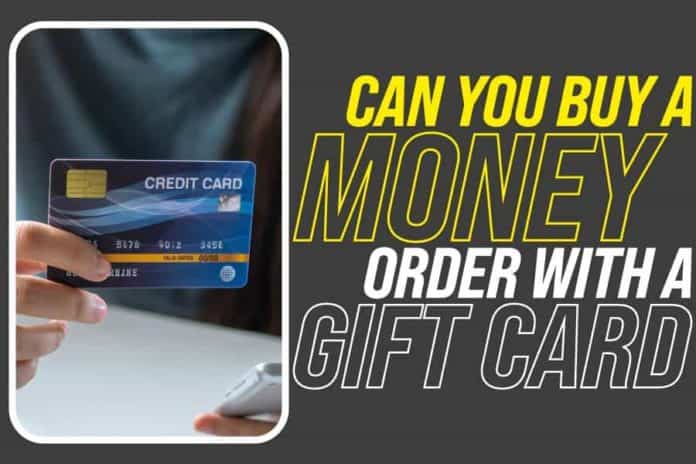When you don’t have enough cash, money orders are a quick method to pay bills, send money, or make purchases.
They work like a personal check but cost less. Money orders are available at most post offices, banks, and retail outlets like Wal-Mart.
If you want to know about this payment method, the fees on money orders, how to use them, who sells them, and more, read this article for everything you need to know about money orders.
Can You Buy A Money Order With A Gift Card?
Yes, you can! But only at select locations, namely; Walmart, USPS, and some Western Union branches. And even then, the gift cards must be Pin-based and pre-paid Visa or Mastercard gift cards.
These locations will accept gift cards such as Vanilla Visa, Netspend, or Green Dot.
What Is A Money Order?
A money order is a document issued by a bank that authorizes the payee to receive a specific sum from the issuing agency.
It is usually a non-negotiable post-dated check. This permits the receiver to cash a check or withdraw funds from the sender’s bank account.
Money orders are often used in checks since they are less expensive and offer more security than traditional checks.
The money order is not the same as a traveler’s check, which must be purchased with cash and can only be used at certain places.
The primary use for money orders is for paying bills and making other payments to individuals or businesses who don’t accept credit cards or checks.
Money orders have many of the same features as a standard check: you can order them in any amount, you can write them on a specific drawee bank, are payable to a third party, and have a specified expiration date.
However, unlike with checks, money orders are typically available only at the post office or at a few select stores that issue them.
People who need to pay for something using cash but don’t want to carry around large amounts of physical money
can use money orders.
Fraudsters and thieves can use a money order in fraudulent activities if it is stolen or lost. Thieves may also steal accounts payable records to duplicate valid money orders. Therefore caution is required when handling money orders.
How It Works
A money order is one of the safest ways to send money to your recipient. It is safer than cash because you can easily track it, unlike money lost or stolen.
The only thing you need to do is purchase a money order at your local post office or other providers. The purchase price includes a handling fee and a unique tracking number.
You will then send it to the recipient of the money through the post office or other mail carriers. The recipient will cash it at any bank or a post office or use it to purchase different things.
If you want to cash it, you should have some form of identification like a passport or driving license.
Where Can I Buy A Money Order?
You can purchase most money orders at:
MoneyGram or Western Union
These companies sell money orders for people who don’t have checking accounts. Look for one of these places in your neighborhood, or ask a friend or family member if they know where one is located.
US post offices
The most common types of money orders are USPS Money Orders and Western Union Money Orders.
Both offer a certain amount of protection for the purchaser, but more widely accepted than USPS Money Orders is the Western Union Money Orders.
USPS charges $1.45 fees for money orders up to $500, and for those worth $1000, they charge $1.95.
At financial institutions such as banks and credit unions
You can walk to any bank or credit union and request a money order. You do not need to have an account with them. You’ll be charged $5 for each transaction.
You can also buy them at some convenience stores or check-cashing outlets such as:
Walmart
You can pay for your money order through a debit card or cash, although you are charged a fee of $1(this amount may vary by location) when using cash and zero transaction when using your debit card. The maximum amount you can transact per day is $1000.
You can also purchase it with your Visa or MasterCard gift card
7-Eleven
At any 7-Eleven store, you are charged a transaction fee of 1-3% depending on the amount, although you can only transact a maximum of $500.
Kmart
At any Kmart, you are charged a transaction fee of $1.50, and a maximum of $500 transaction is allowed.
Kroger
Kroger charges 84-88 cents per transaction and allows up to $1000.
Meijer
Meijer charges 65cents per transaction. The maximum amount per transaction is $500, and you cannot exceed $3500 per day. With over 200 locations in the Midwest, it’s easy to find one that’s nearby.
CVS Pharmacy
You can buy money orders at CVS, and there are a few benefits to doing so. Not only is CVS reliable, but they also have locations all over the country. The cost is $1.25 per $500, and the limited amount you can transact in a day is $2500.
Publix
Publix offers a wide range of money orders and other financial services at the Customer Service desk at all Green Wise market locations.
You can purchase a money order for any amount from $2 to $500, with a transaction fee of 99 cents. There is no limit to the number of times you can transact per day.
Where Can You Buy A Money Order With A Gift Card?
Only three of the above-listed providers accept purchasing a money order with gift cards; and even then, the gift cards must be:
- Pin-based and pre-paid
- Visa gift card or
- Mastercard gift card
Walmart, USPS, and some Western Union branches will accept gift cards as payment, such as Vanilla Visa, Net spend, or Green Dot gift cards.
When Do You Need A Money Order?
- If you don’t have a bank account
- If you don’t want to walk around with a lump sum of money, e.g., when buying art
- When you want the surest and guaranteed way to pay off someone
- When sending money to someone in prison
- When you don’t want any big purchases on your credit card
- You can opt for money orders if you do not wish to reveal your bank account information but still have to pay someone.
Money orders are a simple, cheap way to send money to your bank account information to people you don’t trust.
So, whether you’re paying your contractor, movers, rent, buying a new car, or just sending money across the country, a money order is the way to go.
Sending Money Orders Outside Of The United States
Money orders are one of the safest ways to send money. You can buy them at convenience stores and banks, and you can use them to pay bills and make payments to anyone, anywhere in the world.
But you may have noticed that they are only available in US dollars. What if you want to pay someone in another country? Can you use a US dollar money order to pay a bill or make a payment overseas? Or is it only suitable for paying someone in the United States?
Although sending a money order to someone in another country is possible, it can be tricky. The US Postal Service has strict rules on who you can send a money order to.
They will not deliver to some countries and require you to make the cashier’s check to a bank instead of an individual.
If you want to send a money order to someone overseas, contact the US Postal Service directly or your local post office and ask how they handle mailings. They may ask you for specific details about the recipient before sending the package.
Many countries do not allow you to send a money order. That is because some people use money orders to commit mail fraud. If you do not know the person you are sending it to, you may have problems.
Furthermore, some foreign countries only accept checks and bank transfers. Be sure to check the international acceptance for money orders with the US Post Office before sending anything anywhere overseas.
Conclusion
There are many ways to pay for a money order, but not all of them will work with your gift card. If you want to buy one, it’s best to go to Walmart, USPS, and Western Union using a pre-paid Visa or Mastercard gift card.
We’ve covered everything you need to know about money orders in this article. Whether you’re buying or receiving a money order, we hope that this guide has been helpful and answered some of your questions on the topic.












